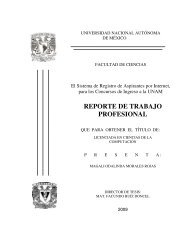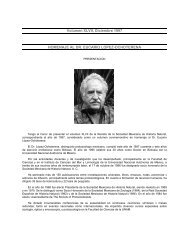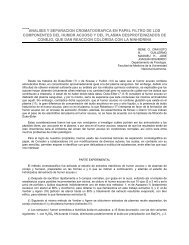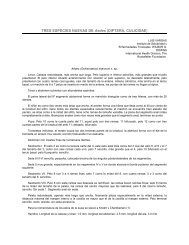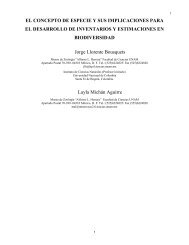(Elphidium: see above) and by various other workers in subsequent times, it remained for J. J. Lister (1885) to be thefirst to <strong>de</strong>lineate the full life cycle of one of these amazing marine "rhizopod sarcodinid" heterotrophs. A species ofthe marine "actinopod sarcodinid" group (a radio<strong>la</strong>rian), inci<strong>de</strong>ntally, was first <strong>de</strong>scribed by Meyen (1834), early inthe century.Now back to (mostly) ciliates! The great works of Friedrich Stein, with volumes on both ciliates and f<strong>la</strong>gel<strong>la</strong>tes(Stein, 1854, 1859, 1867, 1878, 1883), will probably never be surpassed, particu<strong>la</strong>rly because of the precision andmagnificence of his drawings, but also because of his originality in c<strong>la</strong>ssifying the ciliates into four major divisions onthe basis of the structural diversification and the topographical distribution of their externally borne ciliary organelles.More than 100 years <strong>la</strong>ter (e. g., see discussions in Corliss, 1974, 1979b, 1986b), such characteristics are still<strong>la</strong>rgely in use as key characters, notwithstanding our growing mo<strong>de</strong>rn <strong>de</strong>pen<strong>de</strong>nce on ultrastructural and molecu<strong>la</strong>rfeatures in systematics. Stein also worked on symbiotic forms: "higher zoof<strong>la</strong>gel<strong>la</strong>tes" from insects, ophryoscolecidciliates from ruminants, and others. This mo<strong>de</strong>st microscopist/protozoologist from Prague showed but one majorerror in judgment. He proposed an "Acineta Theory" which held that suctorians were simply <strong>la</strong>rval forms of peritrichciliates (Stein, 1849). Soon thereafter, however, Lachmann (1856) carefully <strong>de</strong>monstrated the fal<strong>la</strong>cy of this i<strong>de</strong>a.The Russian worker Shewiakoff may be mentioned next because of his great admiration for Stein (above) andfor his valiant attempt to complete Stein's monographic series on the systematics of ciliates, Stein having neglecteda <strong>de</strong>tailed treatment of the so-called holotrichous species. Near the end of the century, he succee<strong>de</strong>d in producingthe nee<strong>de</strong>d work (Schewiakoff, 1896), still invaluable today. Many years <strong>la</strong>ter, the same Schewiakoff (1926)published an authoritative monograph on the fascinating acantharian "sarcodinids", studied mostly from theMediterranean Sea. Mereschkowsky's (1879) earlier ciliate monograph should be cited here, too.Another remarkable man who spent a number of years in Russia was the Swiss protistologist Eugène Penard,whose monographs also spanned many <strong>de</strong>ca<strong>de</strong>s. Penard (1890, 1902, 1904) treated the rhizopods sensu <strong>la</strong>to,although not the radio<strong>la</strong>rians and other marine forms; and he (Penard, 1920, 1922) produced simi<strong>la</strong>rly authoritativeworks on the suctorians and the ciliates of fresh water. Working principally un<strong>de</strong>r low-power microscopy and mostlywith living material, he <strong>de</strong>tected small structures amazingly well: his eyesight must have been comparable to that ofthe much earlier "philosopher in little things", Antony van Leeuwenhoek!E. Maupas, professionally a librarian in Algiers, was one of the firsts of a small group to commence seriousstudies in an area that we would <strong>la</strong>bel as "genetics" today: see Maupas (1888, 1889). His observations onconjugation and life cycles in ciliates are still appreciated 100 years <strong>la</strong>ter. The "Maupasian life cycle" theory(protozoa pass trough stages of youth, maturity, and old age, with <strong>de</strong>ath occurring unless a "rejuvenescence"intervenes), long maligned after its first promulgation (Maupas, 1889), has now --with refinements-- been fullyaccepted, at least for certain ciliates. Unlike practically all of the other 19th century workers listed in these pages(although Penard would be a major exception), Maupas worked alone, had no <strong>la</strong>rge <strong>la</strong>boratory, had no admiringgraduate stu<strong>de</strong>nts or a coterie of "postdocs" surrounding him, etc. He also contributed monographs in the areas ofcomparative cytology and taxonomy of suctorians and other ciliates: see Maupas (1881, 1883).Another Frenchman, E. G. Balbiani, was also an early stu<strong>de</strong>nt of sexuality and regeneration in ciliates at thesame time as Maupas (see Balbiani, 1888, 1892-1893). He was the first worker to believe and corroborate theshrewd observations and <strong>de</strong>ductions of Leeuwenhoek and O. F. Müller that pairing in Paramecium represented asexual phenomenon, not longitudinal fission. Although primarily an insect embryologist, this fine microscopist alsopublished on the minute parasitic microsporidians (e. g., see Balbiani, 1882), <strong>de</strong>monstrating his wi<strong>de</strong>ly ranginginterests and abilities. Soon after that, Thélohan (1895) published his important monograph on the myxosporidians,another curious group of totally parasitic protozoa. Fabre-Domergue's (1888) <strong>la</strong>rge work should be cited here, too;and that of <strong>de</strong> Fromentel (1874-1876), as well.Returning to purely taxonomic monographs on ciliates, and as another of the very few examples of Americanprotozoologists' major involvements before the 20th century (although recall the works of Leidy, Smith, andMacCallum, cited on earlier pages), the pioneering investigations of Alfred Stokes (1888) <strong>de</strong>serve specialrecognition. Perhaps here, too, should be inserted reference to two other active and influential North Americanbiologists. H. P. Johnson (1893) produced a <strong>la</strong>rge paper on Stentor. And even earlier, H. J. C<strong>la</strong>rk (erroneously citedas "James-C<strong>la</strong>rk" in much of the literature) carried out research on various ciliates and f<strong>la</strong>gel<strong>la</strong>tes and is creditedwith the important discovery of the choanof<strong>la</strong>gel<strong>la</strong>tes ("col<strong>la</strong>r-bearing monads"), to which he taxonomically linked thesponges (C<strong>la</strong>rk, 1868), a view strongly supported by Kent (1880-1882).Richard Hertwig (not to mention his equally well-known brother Oscar) was an experimental embryologist whoalso became a highly reputable protozoologist, carrying out researches on ciliates, heliozoa, and radio<strong>la</strong>rians(Hertwig, 1879, 1889, 1899; Hertwig and Lesser, 1874). A stu<strong>de</strong>nt of Haeckel's (see below), he was inquisitive about
eproduction at the cellu<strong>la</strong>r level and about the morphogenetic processes taking p<strong>la</strong>ce at that level: thus, theunicellu<strong>la</strong>r protozoa were perfect experimental material for him. Goldschmidt (1956) hails R. Hertwig as the greatestzoological teacher of all time, apparently excelling Haeckel, Bütschli, and the other outstanding German professorsof the <strong>la</strong>te 19th and early 20th centuries.HAECKEL, KENT, AND BÜTSCHLI: LEGENDS IN THEIR OWN TIMEErnst Haeckel, in my opinion, was surely one of the most, if not the most, exciting and celebrated Germanbiologists of all time (to date). A genius, an artist, a hard-working microscopist, a <strong>de</strong>dicated Darwinian evolutionist, apopu<strong>la</strong>r person fervently full of iconoc<strong>la</strong>stic i<strong>de</strong>as and concepts (often expressed in pithy aphorisms such as,"Ontogeny briefly recapitu<strong>la</strong>tes phylogeny": the "Biogenetic Law" applied with refinements, to ciliated protozoa bymostly French worker some 75 years <strong>la</strong>ter: see Corliss, 1968) and a taxonomist of precision, Haeckel has left hisimprint in<strong>de</strong>libly on the world of biology. While some of his distinguished contemporaries and a number of leadingbiologist today consi<strong>de</strong>r him a controversial character, Haeckel's published contributions in protozoology/protistologyremain of enormous value: see, for example, his beautifully illustrated monographs on the radio<strong>la</strong>rians, which containsome 3,500 species <strong>de</strong>scribed as new by him (Haeckel, 1866,1878). In resurrecting his (name and concept)Protista, I have called him the "Father of Protistology" (Corliss, 1986c).We need to insert here a brief reference to early major investigations on marine protozoa, forms only recentlyreturning to popu<strong>la</strong>rity because of be<strong>la</strong>ted recognition of their significant role in nutrient recycling (e.g., see thecomprehensive review on the ecology of the benthic heterotrophic f<strong>la</strong>gel<strong>la</strong>tes and ciliates by Patterson et al., 1989).We may cite, as examples of monographs by <strong>la</strong>te 19th century workers, the following works on ciliates, whichcontained new species <strong>de</strong>scriptions in abundance: von Daday (1887)' Entz, Sr. (1884: simi<strong>la</strong>r fine work was carriedout by his son --e.g. see Entz, Jr., 1909). Gourret and Roeser (1886), Perejas<strong>la</strong>wzewa (1886), Quennerstedt(1865-1869), Sterki (1878), and Wrzesuiowski (1870, 1877). It is noteworthy that in "the good old days" bothecological and taxonomic consi<strong>de</strong>rations were often inclu<strong>de</strong>d by the same investigator in a single paper on a givengroup of protists. In many subsequent years, however, the two approaches have become separated (perhaps due tothe growing sophistication of each of them?), an obvious disadvantage to advancement in both of these importantareas of protistological research. But, today, there is growing hope of a welcome return to the combined approach(see a very recent review of the overall situation by Corliss, 1992a).This brings us to the work of the Englishman W. Saville Kent (1880-1882), his culminating monograph on the"Infusoria". This masterful three-volume work on f<strong>la</strong>gel<strong>la</strong>tes, ciliates, and the then separate suctorians (hisTentaculifera) was the first (Pritchard's earlier compi<strong>la</strong>tion, see above, notwithstanding) comprehensive systematictreatment of the protozoa (exclusive of the rhizopods, mycetozoa, and the yet <strong>la</strong>rgely unknown sporozoa sense <strong>la</strong>to)in the English <strong>la</strong>nguage. [A brief section on the sponges is also inclu<strong>de</strong>d]. Kent <strong>de</strong>scribed many new species, and histhird volume consists entirely of p<strong>la</strong>tes, 51 in number, of excellent figures, many unsurpassed in subsequenttreatises on protozoa. Furthermore, he characterized, and often named as new, the higher-level taxa of theorganisms covered; this is particu<strong>la</strong>rly true for the choanof<strong>la</strong>gel<strong>la</strong>tes, the peritrichs, and the suctorians. Some of hiselegant drawings are still reproduced in books published over 100 years <strong>la</strong>ter. In an introductory chapter, Kent offersa most helpful <strong>de</strong>tailed history of protozoology up to 1880; and his bibliography is replete with precise citations to theearly literature of the preceding two hundred years.We come now to Otto Bütschli, long-time Professor of Zoology at the University of Hei<strong>de</strong>lberg: "a giant amonggiants was he!" (Corliss, 1978). With his own training in chemistry and mineralogy, his studies and views on thenature of protop<strong>la</strong>sm were ahead of his time (e.g. see Bütschli, 1892) and still referred to by mo<strong>de</strong>rn cytologists. He,like Maupas and other cited above, was also intrigued by life cycles and sexuality, especially as seen in the ciliates(Bütschli, 1876: see Churchill, 1989b, and Jacobs, 1989, for perceptive analyses of this great study). Finally, hisDobellian <strong>la</strong>bel, "Architect of Protozoology" (Dobell, 1951), is most well <strong>de</strong>served when consi<strong>de</strong>ring his encyclopediccompendia on the systematics of all groups of protozoa (Bütschli, 1880-1882, 1883-1887, 1887-1889). He managedto unify the diverse assemb<strong>la</strong>ges better than anyone preceding him; and his was the first comprehensive account ofall the parasitic "sporozoan" and "cnidosporidian" groups known to that time. Bütschli was superb teacher as well,and he influenced and inspired many young biologists in Germany and abroad to enter the exciting field ofprotozoology. As was true of Kent's monographs, too, Bütschli's early history of protozoology and his extensivebibliography remain as invaluable source materials for stu<strong>de</strong>nts of the history of science.Before closing our brief survey of major 19th century contributions to the <strong>de</strong>velopment and growth of the rapidlyemerging biological science of protozoology, two other outstanding works must be mentioned. One of the earliestand most comprehensive studies on behavior and motor responses in the protists was the well-known book by
- Page 1 and 2: HISTORICALLY IMPORTANT EVENTS, DISC
- Page 4 and 5: aqueous habitats (see the detailed
- Page 6 and 7: With regard to various parasitic (b
- Page 8 and 9: Acephalina (for one subgroup of the
- Page 12 and 13: Vernworn (1889), setting the stage
- Page 14 and 15: esearch, see Foissner, 1987). Sever
- Page 16 and 17: were located at Columbia University
- Page 18 and 19: protozoological research. Pitelka's
- Page 20 and 21: BÜTSCHLI, O., 1876. Studien Über
- Page 22 and 23: CLEVELAND, L.R., 1956. Brief accoun
- Page 24 and 25: DOBELL, C., 1928-1943. Researches o
- Page 26 and 27: Protistenk., 77: 152-174.GELEI, J.
- Page 28 and 29: HERTWIG, R. und E. LESSER, 1874. Ue
- Page 30 and 31: (year 1949): 57-79.KIRBY, H., 1950b
- Page 32 and 33: LEVINE, N.D., 1988. The Protozoan P
- Page 34 and 35: OLIVE, L.S., 1975. The Mycetozoans.
- Page 36 and 37: PUYTORAC, P. de, J. GRAIN, and J.-P
- Page 38 and 39: SONNEBORN, T.M., 1970. Methods in P
- Page 40: WICHTERMAN, R., 1953. The biology o



